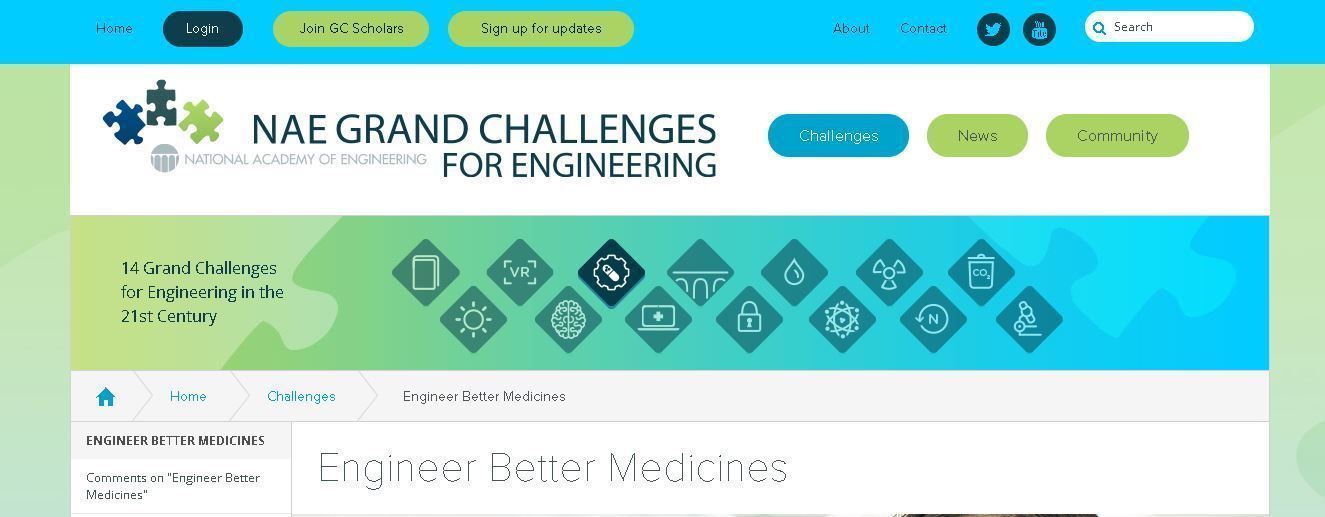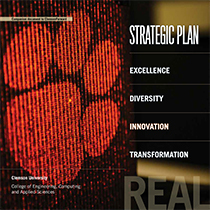Tag Archives for " engineering "
National Academy of Engineering: 14 Grand Challenges For Engineering
“Brain, heart, and muscle power. Not willpower.” – Raj Gavurla
“Everyone is smart. What do you want to study?” – Raj Gavurla
Which one of the NAE Grand Challenges For Engineering is most important to you? I selected two because one is essential to the other thirteen. Combined they have the greatest impact. They are Advance Personalized Learning and Engineer Better Medicines. Which ones do you want to fund?
Advance Personalized Learning
Make Solar Energy Economical
Enhance Virtual Reality
Reverse-Engineer The Brain
Engineer Better Medicines
Advance Health Informatics
Restore and Improve Urban Infrastructure
Secure Cyberspace
Provide Access To Clean Water
Provide Energy From Fusion
Prevent Nuclear Terror
Manage The Nitrogen Cycle
Develop Carbon Sequestration Methods
Engineer The Tools To Scientific Discovery
I selected Advance Personalized Learning because learning, its application, learn how to learn is the catalyst to transform performance, innovation, and/or entrepreneurial leadership and to live a robust life. I selected Engineer Better Medicines because of devastating side effects, allergic reactions, and to eschew medical hardship and emergency room visits.
Engineers are developing new systems to use genetic information, sense small changes in the body, assess new drugs, and deliver vaccines.
Doctors have long known that people differ in susceptibility to disease and response to medicines. But, with little guidance for understanding and adjusting to individual differences, treatments developed have generally been standardized for the many, rather than the few.
How will genetic science change how medicines are made? Click here to learn more: http://engineeringchallenges.org/9129.aspx
“The best way to predict the future is to create it.” – Raj Gavurla
For programs and services, contact Raj Gavurla at 864.569.2315, raj@rajgavurla.com, LiiiVEN.
Clemson University Celebrates Another Successful Year At Artisphere
Sometimes you need to praise people. Especially, the ones you learned or learn from. Take a look:
It’s a connection made possible by an app and website that students created as part of the university’s celebrated Creative Inquiry program and that will be shared with the public as Clemson’s STEAM Exhibit returns to Artisphere for a fourth year.
The bell-ringing will be among 17 activities geared for all ages that shine a light on how science, technology, engineering, arts and math complement each other. The public response to the exhibit in years past has been huge, with more than 75,000 visiting last year alone.
Some of this year’s activities are big hits returning for another run and several will be making their festival debut. Visitors can expect to venture into virtual reality worlds, play an underwater musical instrument and program robots to draw on paper.
One new activity will allow visitors to design an operating room in virtual reality while the audience observes their brainwave activity. Another will teach children about protecting the environment by having them make art out of recycled materials.
The STEAM Exhibit will be free and open to the public for the duration of the festival, which runs May 12-14.
The exhibit will be in the same place as the first three years: the corner of Main and Broad streets next to Grill Marks restaurant.
Here’s a list of activities scheduled for this year:
Color Booth
Experiment with the effects of colored light in this exhibit. Learn how theatrical lighting designers make informed decisions when picking color filters for lights on stage. Visitors can see and experiment with the effects of colored light on theater scenery and costumes and play a challenging guessing game.
EMAG!NE
The STEAM outreach network of the College of Engineering, Computing and Applied Sciences has developed hands-on activities for K-12 students, families and other festival-goers.
Big Data is All Around Us
Gummy bears and virtual reality will help illustrate how many data points a single person leaves in a year. Each gummy bear will represent a single data point, such as a phone call, credit transaction or a log-in. Visitors will also be asked questions about Greenville and their answers will be added to a live database illustrated in a diagram on a large screen. Small children can help build a visualization using chalk and a chalkboard and will receive a gummy bear with parental permission.
Recycled Art
This activity will help educate children about how they can turn trash into something useful. It will make them more familiar with recycling and teaches them about caring for the environment while triggering innovation.
Kinetic Energy Visualized IN Art (KEVIN)
Discover the visual delights of variable motion with these kinetic sculptures. This exhibit displays sculptures that use wind power, gravity, motors and strobe lights to provide unique visual effects.
Real-time Brain Response to Designing a Virtual Operating Room
This experience will allow the user to wear a head-mounted device that provides external input (virtual reality) and internal input (brain wave activity). The user will be able to move equipment in a virtual reality world to design an operating room while the audience observes the user’s brainwave activity in real time.
Playing Fraction Pies
Connect your knowledge of fractions and equivalency to musical notes and rhythms. Simply choose your fractions and press play. Your fractions will transform into a musical composition you can see and hear.
Small Bugs Making Big Waves: How Microbes Benefit Humankind
Despite being so small that they are invisible to our eyes, the microorganisms in our world have a big impact on our lives. This exhibit combines the art of microscopy and the viewing of these microbes with a connection to the daily application of the everyday things they provide. Come by for a live view under a microscope as well as past images of these mysterious creatures and examples of their hidden contributions to society.
Coding for the Carillon: Automating Clemson’s Bell Tower
Watch live video and audio feed from the top of Clemson’s iconic bell tower as songs play entirely automatically through a system implemented by a team of Clemson students in a Creative Inquiry project. Visitors can interact with the bells in real time through a virtual display and keyboard.
Science as Art 2017
Science as Art has challenged Clemson University students, faculty and staff, as well as pre-college students around the state, to share the powerful and inspiring visual images produced in laboratories, workspaces and learning environments. Science as Art aims to draw interest and understanding of science, technology, engineering and mathematics through visually captivating images that are described in basic terms.
The Magnificent Microcosm
If you have ever wondered what a butterfly mouth or a starfish looks like under a microscope, you will not want to miss “The Magnificent Microcosm” sponsored by the Clemson Light Imaging Facility. You will have the chance to look at samples under a microscope, see images from the “HOOKEd on Microscopy” contest and build your own hologram projector to use with a smartphone or tablet.
Drawing with Robots: R2D2 Meets Rembrandt
This exhibit is an interactive activity that introduces children and young adults to computing programing through art. They write the code for shape they wish to create and download it to a small Scribbler robot that then “draws” their picture.
Cutting, Folding, and Stacking: Turning Paper into Resilient Structures
In this hands-on exhibit, attendees will try to fold a piece of paper into a tessellated structure as a scaled model bridge and use precut pieces of cardboard to create a structurally sound mini chair. The purpose of this exhibit is to show that different geometric designs can affect the strength and stability of a structure.
Light flow
Did you know that optical technologies such as lasers and optical fibers are important for applications ranging from communications to health care? This interactive exhibit invites participants to learn more about these technologies from a highly visual and artistic perspective. Light Flow offers opportunities to manipulate laser light with water, send music from a mobile phone to a speaker with a laser beam and create your own colorful shapes using a special form of light-diffusing optical fiber.
Clemson Baja SAE
Clemson Baja is student-designed and -driven organization where participants challenge engineering principles by building a fully capable off-road vehicle.
Drawbot and Air Piston Musical Instrument
Use an iPad to control a Drawbot to create fun pictures from audio files. Come play a unique musical instrument using a rotating disk with specific hole sizes on it and pistons producing the air needed to make sound. Visitors can use the pistons to produce sounds and musical notes.
Biomimetics – Showcasing Nature through the Eyes of an Engineer
Come experience the power and creativity of Mother Nature, from a simple abalone shell to powerful synthetic shark jaws and prehensile seahorse tail marionette.
More about the exhibit:
The STEAM Exhibit is a collaboration of the College of Engineering, Computing and Applied Sciences and the College of Architecture, Arts and Humanities.
The chief organizers of the exhibit are Brad Putman, associate dean for undergraduate studies in the College of Engineering, Computing and Applied Sciences and Shannon Robert, associate professor of scene design in the College of Architecture, Arts and Humanities.
Richard Goodstein, dean of the College of Architecture, Arts and Humanities, said a dedicated group of faculty, students and staff have been working for months to ensure that this year’s exhibit is a success.
“Their efforts illustrate how imagination and creativity can bring together the STEAM disciplines,” he said. “Our collaborative efforts help position Clemson as a national leader in STEAM education.”
Anand Gramopadhye, dean of the College of Engineering, Computing and Applied Sciences said the exhibit serves as a reminder that engineering, computing and science are closely related to the arts and creativity.
“It also gives our students and faculty a place to showcase their work and provide a public service,” he said. “We have had a positive response in past years and are looking forward to another great festival.”
Also this year, Todd Anderson of Clemson University was chosen as one of Artisphere’s four jurors. The assistant professor of art and printmaking will be on the Jury Review Panel with Darin Gehrke, Mercedes Jelinek and Marilyn Zapf.
Kerry Murphy, executive director of Artisphere, said that Clemson’s contributions help enhance the festival.
“The STEAM exhibit is innovative, unique and well-received by festival-goers each year,” she said. “Clemson’s offerings are not only educational but also fun for adults and children alike. We are glad to have Clemson back at Artisphere in 2017.”
“Let go of the thoughts that don’t make you strong.” – Unknown
For programs and services, contact Raj Gavurla at 864.569.2315, raj@rajgavurla.com, LiiiVEN.




